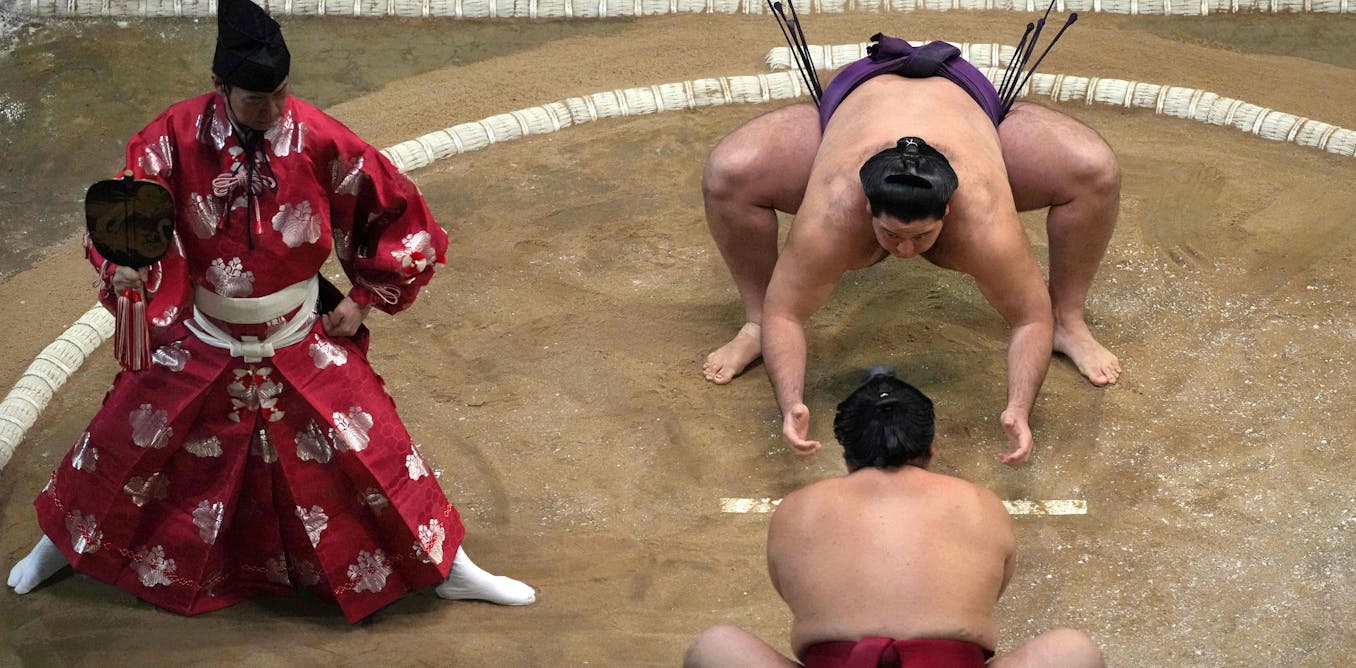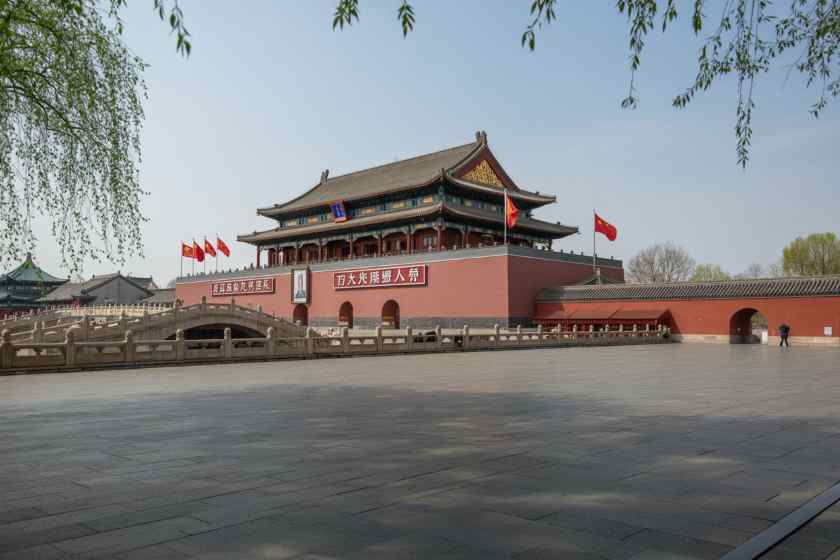Japan’s sumo association turns 100 - but the sport’s rituals have a much older role shaping ideas about the country

A visitor to Japan who wanders into a sumo tournament might be forgiven for thinking they had intruded upon a religious ceremony.Tournaments begin with a line of burly men wearing little more than elaborately decorated aprons walking in a line onto a raised earthen stage. Their names are called as they circle around a ring made of partially buried bales of rice straw. Turning toward the center, they clap, lift their aprons, raise their arms upward, and then exit without a word.Then two of those men face each other, crouching, clapping their hands together and stomping on the ground. They pause repeatedly to rinse their mouths with water and toss salt into the ring.Overseeing their movements is a man outfitted in a colorful kimono and a black hat resembling that of a Shinto priest and holding a tasseled fan. After a subtle gesture with his fan, they finally grapple – and only then would the uninformed observer realize that the performance was an athletic event.Every sport has its rituals, from the All Blacks rugby team’s pregame haka to the polite handshake between victor and vanquished over the tennis court net. Some, like many sumo rituals, have roots in religious practices. A few hundred years ago, competitions were frequently held at temples and shrines as part of festivals.Today, sumo is a modern sport with records, rules and a governing institution that celebrated its 100th anniversary in October 2025. But those religious roots are still visible. The salt the wrestlers throw, for example, is a purifying element. The clapping is a way of drawing the attention of the gods.As a historian of modern Japan and a scholar of sports and diplomacy, I have seen many ways in which sports are much more than “just a game.” Sport rituals are an important part of those wider meanings. In fact, sumo and its rituals have helped shape foreign perceptions of Japan for at least 170 years.First impressionsThe first sumo tournament known to have been observed by American spectators was held in March 1854, in honor of a treaty establishing diplomatic relations between the United States and Japan. Described in the personal journal kept by Commodore Matthew Perry, the leader of the mission to Japan, the exhibition before gawking American sailors seemed designed to impress.Before the matches began, the athletes put on a performance of strength, loading the American ships with a gift of some 200 bales of rice from the Japanese government. Perry describes how two dozen huge men, “naked with the exception of a narrow girdle around the loins,” paraded before the American crew before getting to work, each shouldering two 135-pound bales.If the actual sumo competition was intended to inspire appreciation of Japanese culture, it backfired. Perry’s descriptions of the wrestlers were full of unflattering animal metaphors. He wrote that they resembled “stall-fed bulls” more than human beings and made noises like “dogs in combat.”At the time, sports as we know them today were just emerging in England and the United States. Some of the earliest rules of soccer were recorded in the 1840s, and baseball’s growing popularity led to the development of professional leagues after the U.S. Civil War.With this American idea of sports in Perry’s mind, the sumo tournament did not impress him. He called the bouts a “farce” and judged the wrestlers’ physique as one that “to our ideas of athletic qualities would seem to incapacitate him from any violent exercise.”In the mid-19th century, Japan was relatively isolated from the Western world. Most Americans knew almost nothing about the country and considered it backward, even barbaric. The two cultures’ differing ideas of sports meant that sumo only added to American views of Japan as strange and uncivilized.A competing sportSports diplomacy had a more positive impact on American views of Japan in the early 20th century, thanks to a different game: baseball.After the fall of the shogunate in 1868, the new Japanese government – made up of oligarchs ruling in the name of the Meiji Emperor – employed Americans to help implement reforms. Some of them brought along America’s pastime, which became very popular within a few decades.By the 1910s and ‘20s, Japanese college teams were regularly traveling to the U.S., where newspapers praised their skills and their sportsmanship.Some of the rituals in a Japanese baseball game, like a ceremonial first pitch, were familiar to American observers. Others, like a team bow toward the umpire, were quite a contrast, but struck them as superior to the rowdiness of American players and fans.At the time, Japan’s Westernizing reforms and recent military victories over China and Russia had already improved Americans’ impressions of the country. Former baseball player Harry Kingman, writing about a game he watched during a 1927 stint coaching a Tokyo college team, explained the Japanese turn toward baseball as part of the nation’s modernization.Sumo, however, continued to be the most popular sport in Japan until the 1990s, when baseball took that title. But the initial popularity of this American import caused some anxiety within the sumo world: A foreign game seemed to be taking over and stealing sumo’s fans.Amid these changes, professional sumo’s governing institutions, which were divided into competing associations based in Tokyo and Osaka, joined forces. They officially unified in 1925 as the organization that would become today’s Japan Sumo Association.Can sumo be cool?Japanese popular culture now captivates people around the world. In 2002, journalist Douglas McGray wrote about the soft power conferred by what he called the nation’s “gross national cool.” But he noted sumo as an exception, blaming its leadership’s insular attitudes.Perhaps sumo’s biggest hurdle to building an international fan base is its attitude toward foreigners. Immigration is controversial in Japan. The population is relatively homogeneous, and barriers to naturalization are high.In contrast to sports like baseball, soccer and rugby, where “imported” players abound, there are few foreign sumo wrestlers, and their success seems to rankle. In 1993, a Hawaiian named Akebono became the first foreigner to reach the top rank of “yokozuna,” sparking a temporary hold on recruiting sumo wrestlers from outside Japan.Constraints were gradually softened, and the number of non-Japanese professional wrestlers has been rising. They still represent a small minority, but their success often sparks discussions about the place of foreigners in the sport.Though sumo has gained some traction outside of Japan, its rituals still occasionally create negative impressions of Japanese culture. At a tournament in 2018, for example, a local official collapsed while giving a speech. Female medics who rushed to help him were told to leave the sumo ring, considered a sacred space polluted by a woman’s presence. The chairman of the Japan Sumo Association later apologized, but the incident brought criticism that the sumo world was clinging to anachronistic traditions.Sumo continues to change. A 1926 Tokyo government ban on women’s sumo is no longer in force, and there are now some female wrestlers in amateur clubs. But women are still barred from professional competition.Tournaments are certainly popular with tourists, but they generally go for a one-time experience. One might ask if sumo can change enough to play an effective role in Japan’s sports diplomacy. The answer depends on whether sumo leaders are more interested in maintaining the sport’s Japanese identity or building global connections.












